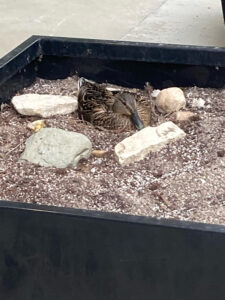In mid-April, we got a call from a concerned Montessori teacher. Her school is in downtown Cedar Rapids amid office buildings, restaurants, and taverns. Cars constantly buzz by.
She’d spotted a hen mallard duck nesting in the school’s playground and asked what she could do to help it. She knew what a great teaching opportunity this was. Children and teachers have spent the past several weeks observing and documenting the mama Mallard. They even named her – Mallory. Her partner is dubbed Howard.
Over the years we’ve fielded many similar calls from people in urban areas spotting nesting mallards and Canada geese.
For years people have heard that transforming natural areas to cities and suburbs destroys wildlife habitat. It does, at least for wildlife that shun people. However, many wild animals increase as an area urbanizes. House sparrows, rats, and pigeons come to mind, but some other beneficiaries are more welcome.
Cedar Rapids is bisected by the Cedar River, and many ducks nest downtown. Often a hen duck will nest in a large raised concrete flower pot, or as the Montessori School discovered, in the kids’ playground.

This female mallard is quite at home near the Montessori school.
Although this may seem odd, a city may be the safest nesting place. Mallards nest on the ground. Raccoons, dogs, opossums, and a slew of other predators love dining on eggs. Most duck nests out in the country get predated. All that’s left after a raccoon raid is eggshells. Fortunately, many waterfowl species renest, and usually enough nests are successful to maintain the population.
It may be that a nest in a raised concrete flower pot reduces the odds of a raccoon raid.
For many years a duck nested under a shrub near the front door of Washington High School. The hundreds of students who passed by the nest may have discouraged predators.
Canada geese also aren’t shy about people, factories, railroads, or even Interstate Highways. Many nest along Cedar Lake in an industrial area of Cedar Rapids. Normally they hide their nest, but we found one goose nesting immediately adjacent to a busy trail in plain sight.
This bird is now so numerous in many cities that they’re considered a nuisance, although we love seeing and hearing them.
So, what should someone do if they find a nesting duck or goose in a seemingly unlikely and unsafe place? The answer is simple. Just like the Montessori classes, Leave it alone, take photos, and enjoy having a beautiful and interesting animal make its home near people.


When I was still working, I discovered a nesting duck under a shrub bordering the parking lot at Evergreen Packaging on 6th St SW. I alerted the maintenance team, who placed traffic cones in the parking spots in front of the duck’s nesting place so it would not be disturbed by cars pulling right up to the nest. Unfortunately, the very next morning, the parking spaces were littered with broken egg shells. We often encountered turkey and deer in the parking lots at work (one deer tried jumping through the window into my office!) so I suppose it’s not hard to believe there were raccoons around too. We were sad to lose our mama duck.
Sheri, You are right, lots of animals do interact with humans. That is a sad ending to the mama duck and her eggs.
Absolutely, leave alone. I live where we have many ducks and geese. The Mom’s , parents scout for days to find the best nesting places. We should trust their judgement-instincts.
Wow! That is really cool that the mallard has nested so close. that way the students can enjoy the growing family.
? When I see and hear only one Canada goose fly over my house, it makes me wonder if it has lost its mate to a predator. I hope not, but is that the possible answer? On second thought perhaps the mate is nesting, but that seems unlikely that the goose would leave her.
Thanks, Jackie. Geese are good parents and all seem to join in with different babies to care for them.